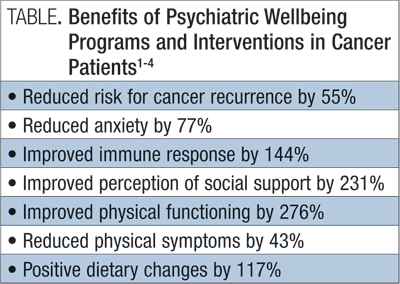Print Friendly
The Importance of Mental Health Screening and Treatment in Cancer Patients
The Importance of Mental Health Screening and Treatment in Cancer Patients
Professor, Departments of Psychology, Obstetrics and Gynecology, The Ohio State University, Columbus, OH
First published in Psychiatry Weekly, Volume 9, Issue 8, May 19, 2014
Introduction
In 2013, the American College of Surgeons Commission on Cancer announced that, beginning in 2017, cancer centers will be required to implement protocols to screen cancer patients for “psychosocial distress” and to refer patients to appropriate treatment when applicable. This new criterion for accreditation undoubtedly reflects an appreciation of the body of literature showing that failure to address high stress and low support in some cancer patients is associated with an increased risk of anxiety and mood disorders. Successful treatment of such symptoms is also associated with longer survival and reduced risk for recurrence of cancer. (Table)

Barbara Andersen, PhD, has studied the psychological responses to cancer diagnosis and treatment for several decades. Andersen and Julia H. Rowland, PhD, co-chaired a panel of researchers, clinicians, and advocates convened by the American Society of Clinical Oncology (ASCO) to review guidelines for screening anxiety and depressive symptoms in cancer patients. The “Pan-Canadian Guideline on Screening, Assessment and Care of Psychosocial Distress (Depression, Anxiety) in Adults with Cancer,”1 was selected by this panel for review and adaptation because of its intentional emphasis on discrete and diagnosable anxiety and depressive symptoms as opposed to the catchall concept of “distress.”
Psychiatric Wellbeing of Cancer Patients
Among cancer patients, one meta-analysis reported an estimated prevalence of 20.7% for mood disorders, 10.3% for anxiety disorders, and 19.4% for adjustment disorders.5 The panel recommends screening for anxiety and depression (using screening tools GAD-7 and PHQ-9, respectively) around the time of cancer diagnosis or when initiating treatment, and at relevant times thereafter, such as at the end of treatment or during the next 12 months. For example, for a cancer patient who will have surgery followed by adjuvant chemotherapy, there might be an initial screening, one after adjuvant chemotherapy, and others periodically during follow-up.
“Many times, during the throes of chemotherapy, people can get pushed over into symptoms of depression,” says Dr. Andersen. “Cancer patients often (and reasonably) attribute symptoms to the circumstances of their diagnosis or being in treatment. But when treatment has ended and 6 months later their mood still hasn’t lifted, and there is still no motivation or interest in doing things, that may be something different entirely—possibly a new or recurrent episode of MDD. In fact, around half of the people with an episode of MDD following cancer diagnosis have already experienced a previous episode of MDD.”
The present guideline includes triage models for depression and anxiety symptoms in cancer patients, which distinguish treatment approaches on the basis of none/mild, moderate, and moderate to severe symptoms.
“Many newly diagnosed cancer patients—perhaps as many as 25%— do well, and additional psychosocial support from a health care setting is often not needed,” says Dr. Andersen. “They may already have good coping skills, economic and social resources, and no history of MDD. Another 15%–25% will do well with modest support, such as receiving information about cancer and its treatment, and opportunities to ask questions in a supportive environment. It’s really the other 50% who need our active, substantive support and treatment. They may have difficult transitory symptoms or other chronic problems that make them vulnerable to stress, depression, and anxiety. Empirically supported group or individual therapy, with or without adjuvant psychopharmacologic treatment, is often appropriate.”
Long-Term Considerations
Cancer survivors experience high rates of anxiety (17.9%) and depression (11.6%) at 2-year follow-up.5 Early assessment and treatment of such symptoms in cancer patients may improve not only physical outcomes for patients but also the overall burden borne by patients, loved ones, and care givers. Even the relatively small proportion of cancer patients who need little to no additional psychosocial support throughout cancer illness and treatment may be susceptible to anxiety and depression with recurrence. As recognition and implementation of wellness programs for cancer patients continues to improve, it is possible that the mental toll of cancer may therefore diminish for many patients.
This interview was conducted on April 29, 2014 by Lonnie Stoltzfoos
Disclosure: Dr. Andersen has received grant/research funding from the National Cancer Institute.
References:
1. Andersen BL, Derubeis RJ, Berman BS, et al. Screening, Assessment, and Care of Anxiety and Depressive Symptoms in Adults With Cancer: An American Society of Clinical Oncology Guideline Adaptation. J Clin Oncol. 2014.
2. Andersen BL, Farrar WB, Golden-Kreutz DM, et al. Psychological, behavioral, and immune changes after a psychological intervention: a clinical trial. J Clin Oncol. 2004;22(17):3570-80.
3. Andersen BL, Farrar WB, Golden-Kreutz D, et al. Distress reduction from a psychological intervention contributes to improved health for cancer patients. Brain Behav Immun. 2007;21(7):953-61.
4. Andersen BL, Yang HC, Farrar WB, et al. Psychologic intervention improves survival for breast cancer patients: a randomized clinical trial. Cancer. 2008;113(12):3450-8.
5. Mitchell AJ, Chan M, Bhatti H, et al. Prevalence of depression, anxiety, and adjustment disorder in oncological, haematological, and palliative-care settings: a meta-analysis of 94 interview-based studies. Lancet Oncol. 2011;12(2):160-74.